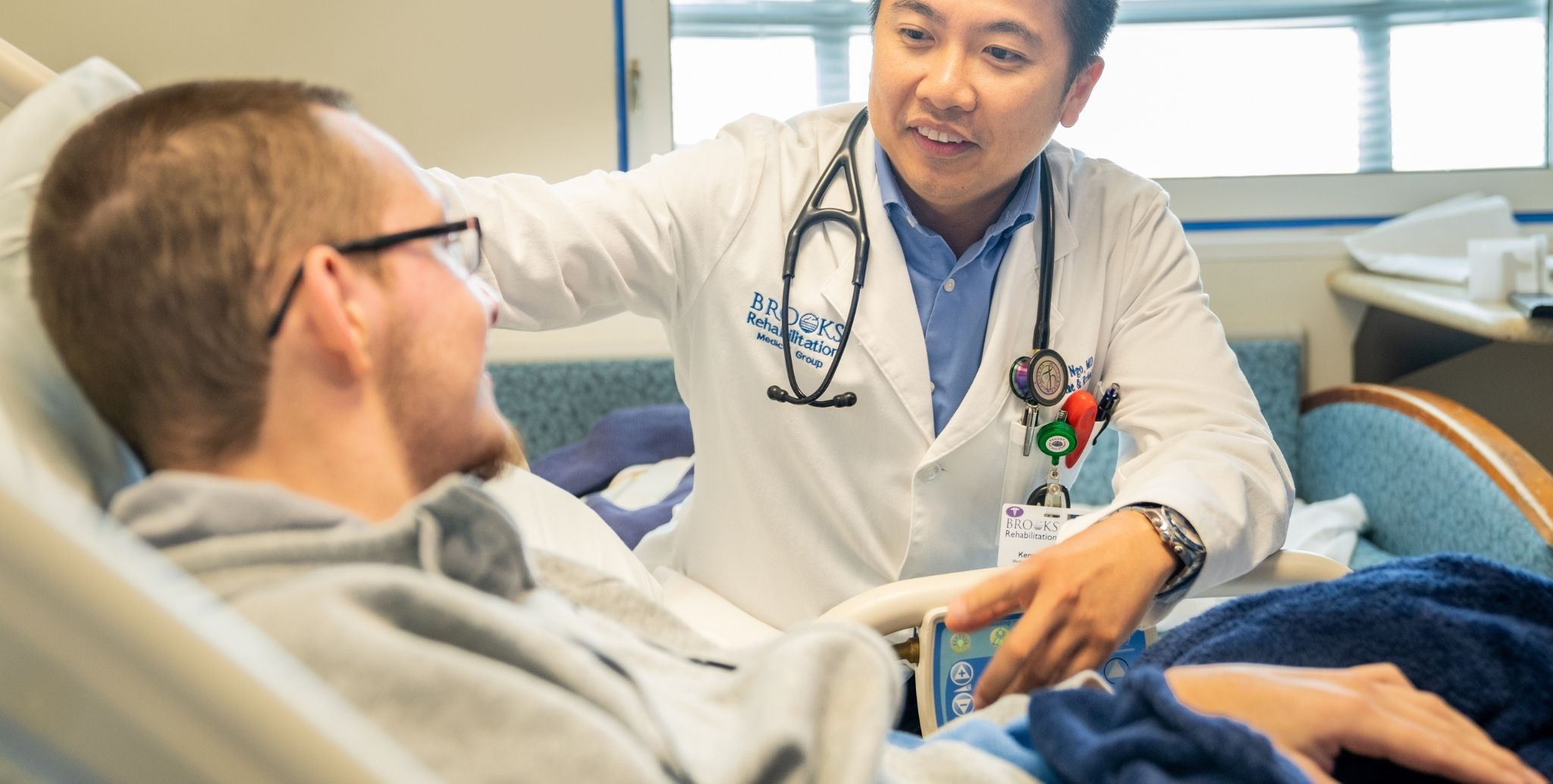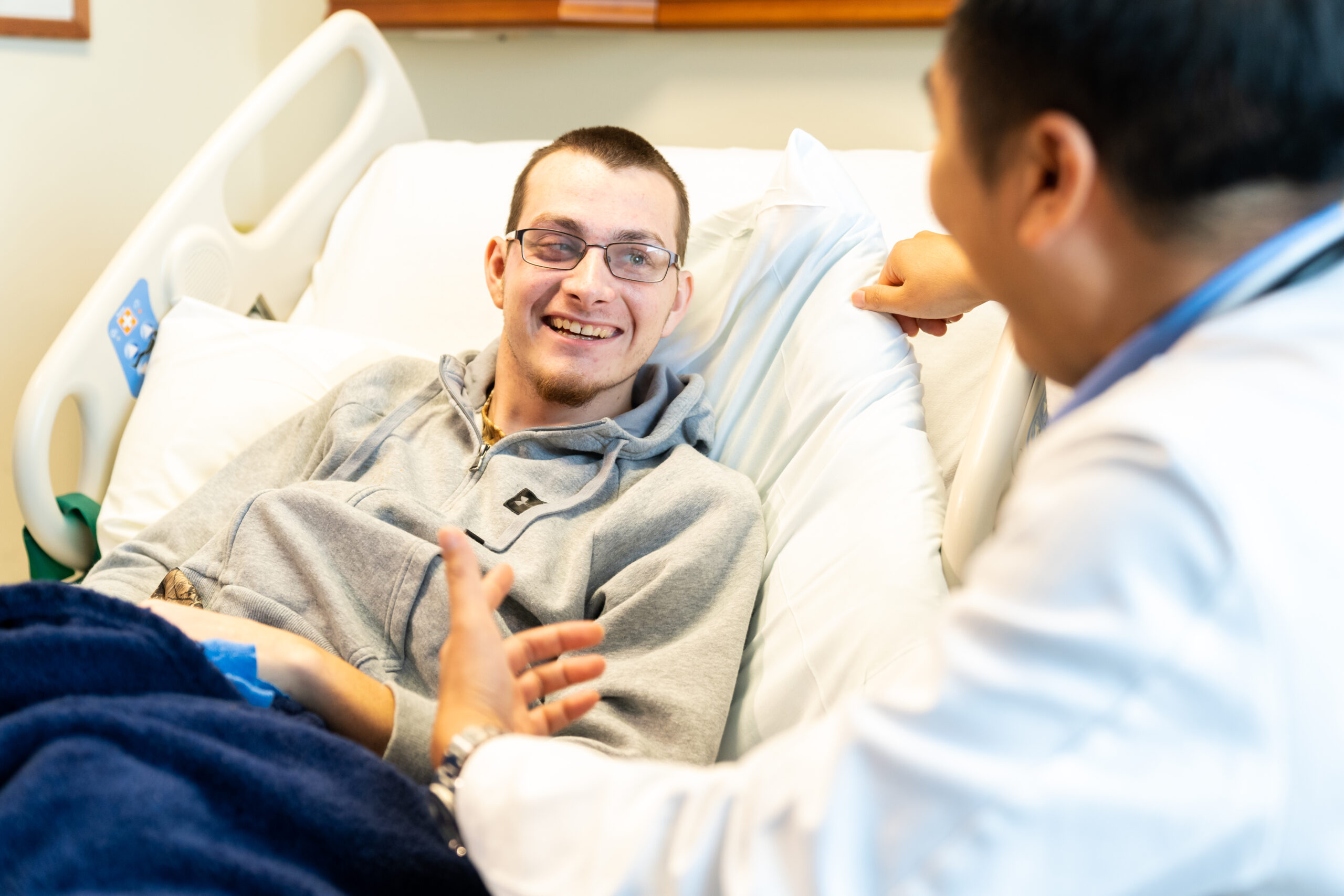Traumatic Brain Injury: Types, Treatments and Recovery

Back to physical health resource hub
Traumatic brain injury (TBI) treatments and recovery differ greatly depending on the injury and what was impacted. At Brooks Rehabilitation, 27% of patients treated at its rehabilitation hospitals are admitted with a brain injury. In 2022, Brooks clinicians treated over 500 patients for a traumatic brain injury.
In this article, we will cover the following topics:
What is a Traumatic Brain Injury?
A traumatic brain injury refers to any jolt or blow to the head that impact the brain’s ability to function normally.
The seriousness of the brain injury depends on which part of the brain was impacted, how it was injured and the type and severity of the damage. Mild brain injuries generally heal in a short amount of time, while a severe brain injury can take months to heal, cause permanent damage or even death.
Because a brain injury also affects the nervous system, it can significantly impact other parts of the body, leading to a number of possible disabilities. Ensuring that the brain injury is properly assessed is important for making sure a person receives the best treatments available.
“A common misconception is that if a patient looks fine from the outside, then everything is fine,” explains Dr. Kenneth Ngo, Medical Director for the Brain Injury Program at Brooks Rehabilitation Hospital – University Campus. “The brain is complicated. You have to spend time understanding how the brain works normally and how to tease out what’s abnormal and what’s not.”

Types of Traumatic Brain Injuries
Brain injuries vary in seriousness based on several factors, including:
- Cause of the trauma (e.g., gunshot wound, car accident, etc.)
- Whether the person lost consciousness and for how long
- Type of damage to the brain (e.g., brain bleeding, bruising, torn tissues, etc.), and other symptoms.
There are two primary types of traumatic brain injuries:
- Closed TBIs occur when an exterior force causes a jolt or blow to the head without penetrating the skull.
- Open or penetrating brain injuries refer to when the skull is penetrated, such as by a knife or a bullet.
Traumatic brain injuries also can be categorized by severity:
- Mild concussions (mTBI) are the most common type of brain injuries. These injuries may involve loss of consciousness for less than 30 minutes. People with mTBIs may feel dazed or confused for a few days.
- Moderate brain injuries involve losing consciousness for at least 30 minutes but less than 24 hours.
- Severe brain injuries involve losing consciousness for longer than one day.
- Uncomplicated TBIs refer to brain injuries where head CT scans and brain MRIs remain normal.
- Complicated TBI are events where the CT scan or brain MRI is abnormal.
Most Common Causes of TBIs
Most traumatic brain injuries are caused by falls, especially among children and older people. Other common causes of traumatic brain injuries include:
- An object that penetrates the skull and brain tissue, like a knife or bullet
- Collisions, such as a bicycle or motor vehicle accident
- Assaults, including child or domestic abuse. Shaken baby syndrome is a common TBI among infants.
- Sports injuries, particularly from high-impact sports
- Combat injuries or explosive blasts
Symptoms of a traumatic brain injury
Potential brain trauma can be serious and often requires emergency care.
Information on the cause of an injury and any noticeable changes can help. Brain injury symptoms usually occur within 24 hours and may include:
- Loss of consciousness
- Convulsions or seizures
- Slurred speech
- Loss of coordination
- Nausea or vomiting
- Headaches
- Dizziness
- Memory problems
- Confusion
- Mood, personality or behavior changes
- Increased blood pressure
- Increased sensitivity to light or smell
- Sleep changes
- Vision changes
- Dilated pupils
- Difficulty concentrating
Additionally, infants and young children may cry more than normal and/or refuse to eat or drink. Healthcare providers may also order tests to help determine if and to what extent the brain has been injured, including:
- A CT scan or MRI to look for bleeding or swelling caused by brain trauma
- A neuropsychological evaluation, which checks for things like memory and thinking skills, motor function, and sensory functions
- A specialized blood test that checks for proteins that may indicate a concussion
- The Glasgow Coma Scale (GSC), a tool used to determine a coma patient’s level of consciousness and the injury severity
Traumatic Brain Injury Treatments
For some patients, rest – which often includes avoiding any electronics – is enough. Surgery may be required if there is swelling or bleeding of the brain. Additionally, if there is swelling, doctors may insert a probe called an intracranial pressure monitor through the skull to help monitor the pressure.
In more serious instances, intensive TBI treatments through rehabilitative therapies may be necessary, including one or more of the following:
- Speech therapy
- Occupational therapy
- Physical therapy
- Cognitive therapy
- Physical reconditioning through group therapies
- Psychotherapy
- Support groups
Some patients may receive therapy and rehabilitation services either at home or through outpatient treatment. In more severe situations, patients may require continued care through a rehabilitation hospital or a skilled nursing center where their care is under the oversight of doctors and nurses specially trained for these types of injuries.
The average length of stay in a rehabilitation hospital for TBI patients is 17 days with over 970 minutes of therapy being provided per week to help the patient begin to recover.
After a patient is discharged from the hospital, they may go to a skilled nursing facility if more intensive therapy and care is needed, or home where treatment will still continue through outpatient programs.

How long does it take for the brain to heal?
Because brain injury patients are all different, there is no clear answer on how long it takes for the brain to heal. Mild injuries can be better within a few hours or days, while severe injuries can take months or more, and some injuries may never fully heal.
Continuing TBI Recovery
There are 1.7 million people in the U.S. suffering from a TBI. The groups at highest risk are older adolescents, ages 15-19, or older adults 65+, according to data from NIH: National Center for Biotechnology Information.
Center for Disease Control data shows that in 2020y, 214,000 people were hospitalized due to traumatic brain injury and over 69,000 deaths in 2021 resulted from a TBI-related injury.
Knowing the risks, treatment options and what recovery looks like is important to understand if you or a loved one has been affected by a traumatic brain injury.
Healing from a traumatic brain injury involves not only physical and mental rehabilitation, but also emotional healing. Severe brain injuries require more coping skills, as patients must relearn how to do and manage many activities of daily living.
TBI programs should have a variety of individualized and group therapies to help patients relearn skills, as well as build a community with others who are going through similar journeys.
These programs are typically overseen by neuropsychologists who help patients better understand where they are having problems with their functioning. They then work with the patient to develop an individualized, intensive multi-disciplinary program to help move recovery forward. Typically these programs are 6-hours a day where the patient participates in intensive physical, speech and occupational rehabilitative therapies, group counseling and individual counseling to continue healing.
There are various ways brain injury survivors can continue their recovery and stay active after they complete their extensive brain injury day program, as well. Specialized outpatient clinics with specialized technology is available at Brooks. There are also a brain injury clubhouse to help participates practice daily living activities and centers for aphasia, a speech condition that can occur after a brain injury, or adaptive sports and recreation programs to stay active and make connections with others.
Patient Recovery Stories
Watch our video on how Brooks helped rising star boxer Prichard Colon heal from a traumatic brain injury after receiving illegal blows to the head during a boxing match.
Learn More About TBI Treatments at Brooks
If you or a loved one experienced a traumatic brain injury, Brooks can help. Through a highly trained and knowledgeable team of clinicians and physical medicine and rehabilitation doctors, neuropsychologists, case managers and more, Brooks has experience treating patients considered 1% in complexity for traumatic injury in the nation. Learn more about our Brain Injury Rehabilitation Program and patient outcomes.


